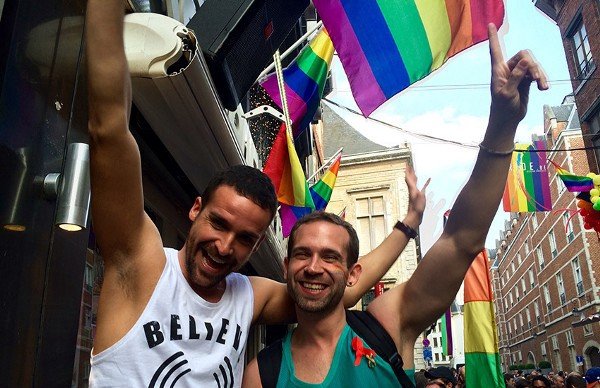Gays get organised in Brussels

I met Francois Massoz at the bar operated by Rainbow House in Brussels on the rue du Marche au Charbon — just around the corner from their main administrative office.
Massoz is in charge of communications for Rainbow House. Young, passionate, handsome, and with an appealing French accent, Massoz talked articulately about the purpose of Rainbow House and its role within the vibrant LGBT community of Brussels.
What is Rainbow House?
We are the umbrella organisation for the LGBT organisations of Brussels. We were established nearly 15 years ago. We currently represent 40 organisations. Member organisations pay a small membership fee each year.
What are some of the key activities of Rainbow House?
A lot of our member organisations don’t have their own office space, so our offices give our members somewhere to work or hold meetings and events, and this also encourages collaboration between organisations.
We produce a number of key publications: Out In Brussels is a small pocket-sized guide to the bars, events, and LGBT associations of Brussels. And Rainbow Times is a magazine that we produce three times each year.
We also actively promote collaboration between our member organisations. Plus we organise Pride Week.
Does Rainbow House undertake any health education or HIV prevention work?
While a number of our members organisations are focused on health and prevention, Rainbow House is not itself focused on HIV prevention. However we do currently have two big projects underway.
Firstly the HIV Cafe which is an event that is held once a month, creating a safe space for HIV positive people. This isn’t just for LGBT people, but for anyone that is HIV positive. This has received a lot of media coverage and one of our main aims is to challenge the stigmatisation of people living with HIV.
Our second big project is Knitting Against AIDS. This involves people from the fashion industry but we’re also working with schools and retirement homes, getting people involved in knitting scarves while at the same time discussing and educating people about HIV and AIDS. We then hold a fashion show where the scarves are modelled by people who are HIV positive, the scarves are sold and the money raised is donated to HIV prevention associations.
We are also participating in the Sialon project. This is a European-wide project that is conducting saliva-based HIV testing in clubs, bars and saunas to collect data about the number of men with HIV. Participants have the option to learn their results but this is not essential as the main priority is to collect the data.
In addition we work with our member organisations to coordinate activities around World AIDS Day in December each year.
How is Rainbow House funded?
We are subsidised by the government, but it is quite a complicated system. There are a lot of different government departments we have to apply to for funding, so it takes a lot of time and effort.
One of the challenges is everything is designed as short-term project funding, so you are often waiting for a long time to know if an application has been successful, and we need to apply for a lot of different projects in order to maintain the funding that we need to pay our staff. We have a core staff of five people.
There is only limited private funding available, so continuing to access government funding is essential.
This ongoing challenge regarding funding is one reason a new organisation — Regenboogvrienden (friends of Rainbow House) — has been established as a fundraising vehicle.
What does the future hold for Rainbow House?
If we continue to find money there will be a good future. If we don’t, we will still try to survive.
While everything we’re doing doesn’t require a lot of money, we still ultimately depend on the support of the government. If anything changes then we could disappear very quickly. The good thing is that we have existed for nearly 15 years now so I am hopeful for the future.